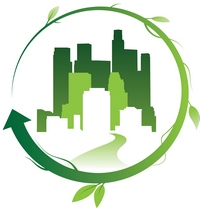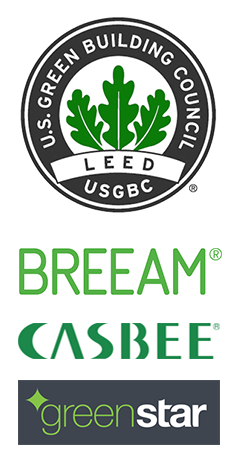Green Building
 Buildings are reported to consume 32% of the world’s resources, produce 40% of the waste being deposited into landfill sites, and contribute 40% of greenhouse gas emissions (GBCA 2008). Improving efficiency in the consumption of energy, water and other resources in the built environment is undoubtedly one of the most sustainable and feasible measures for reducing human impacts on the environment. Therefore, the topic of green buildings has attracted increasing attention worldwide (GBCA 2008). According to the U.S. Department of Energy, green buildings consume 25% less energy and generate 34% lower greenhouse gas emissions (USDOE, 2011).
Buildings are reported to consume 32% of the world’s resources, produce 40% of the waste being deposited into landfill sites, and contribute 40% of greenhouse gas emissions (GBCA 2008). Improving efficiency in the consumption of energy, water and other resources in the built environment is undoubtedly one of the most sustainable and feasible measures for reducing human impacts on the environment. Therefore, the topic of green buildings has attracted increasing attention worldwide (GBCA 2008). According to the U.S. Department of Energy, green buildings consume 25% less energy and generate 34% lower greenhouse gas emissions (USDOE, 2011).
A green building refers to a structure and operation process that is environmentally responsible and resource-efficient throughout a building’s life-cycle: from siting to design, construction, operation, maintenance, renovation, and demolition (Turner et al. 2008). The American Society of Testing and Materials (ASTM) defines a “green building” as a building that “optimizes efficiencies in resource management and operational performance, and minimizes risks to human health and the environment” (ASTM 2008). According to the U.S. Environmental Protection Agency, a green building is comprised of 7 components, which are:
- energy efficiency and renewable energy,
- water efficiency,
- environmentally preferable building materials and specifications,
- waste reduction,
- toxics reduction,
- indoor air quality, and
- smart growth and sustainable development.
 The essence of a green building is an optimization of one or more of these components (USEPA 2014). Green buildings could minimize the consumption of water and materials, reduce the pollution and human impacts to the environment, and enhance occupant health and comfort. A study of 22 green buildings in the United States shows that green buildings could result in 11% less water use and 27% higher occupant satisfaction (USDOE, 2011).
The essence of a green building is an optimization of one or more of these components (USEPA 2014). Green buildings could minimize the consumption of water and materials, reduce the pollution and human impacts to the environment, and enhance occupant health and comfort. A study of 22 green buildings in the United States shows that green buildings could result in 11% less water use and 27% higher occupant satisfaction (USDOE, 2011).
To be labeled as a green building, a building should be assessed and certified in accordance with a green building certification standard, which provides the guidelines to measure, improve, certify, benchmark, and label the whole-life environmental sustainability and performance. Different countries have brought in their own certification standards for getting their buildings certified. Some of the commonly referenced standards include LEED in the U.S., Building Research Establishment Environmental Assessment Method (BREEAM) in the United Kingdom, Green Star in Australia, Comprehensive Assessment System for Built Environment Efficiency (CASBEE) in Japan, etc. Among these standards, LEED and BREEAM are two of the most popular ones in terms of the number of certified projects. In fact, according to the official websites, there were over 78,000 building projects certified by LEED by 2015 and about 425,000 certified by BREEAM by 2015, respectively. However, BREEAM suffers from a lack of transparency. For instance, data on the number of buildings certified in each category and what ratings they achieved are hard to obtain, mainly because historically, it was seen as a barrier to adoption of BREEAM if this information was made public (Inbuilt Ltd 2010). As a result, LEED was chosen as the green building certification standard of focus in this thesis.
LEED
LEED, developed by the United States Green Building Council (USGBC), has evolved since 1998 to represent and incorporate emerging green building technologies. The first LEED Pilot Project Program, also referred to as LEED v1.0, was launched in August 1998. After extensive modifications, LEED v2.0 was released in March 2000, with LEED v2.1 following in 2002, LEED v2.2 following in 2005, LEED v3 (also well known as LEED v2009) in 2008 and the newest version, LEED v4, in 2013 (USGBC 2013).
LEED is a credit based rating system, in which each credit evaluates one aspect of building performance and grades with relative credit points. The total achieved LEED credit points determine the award of different LEED grade levels, ranging from Platinum, Gold, Silver, to Certified. Take LEED v3 for New Construction and Major Renovations as an example. Prerequisites and credits in this system address 7 topics:
- Sustainable Sites (SS),
- Water Efficiency (WE),
- Energy and Atmosphere (EA),
- Materials and Resources (MR),
- Indoor Environmental Quality (IEQ),
- Innovation in Design (ID),
- Regional Priority (RP).
